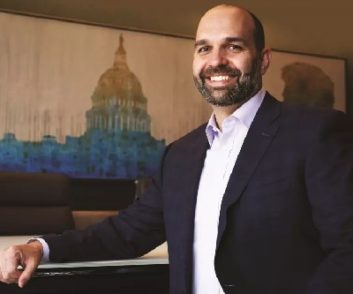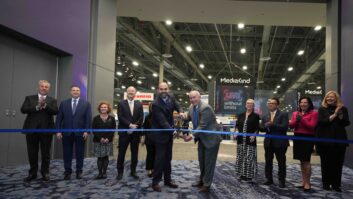Earlier this year, Gordon Smith, who has led the National Association of Broadcasters (NAB) as its CEO for more than a decade, announced his retirement. Curtis LeGeyt, NAB’s current chief operating officer, has been appointed as the next president and CEO of the organisation.
LeGeyt, who is set to take over 1 January 2022, has been with NAB for nearly a decade, previously serving five years as NAB’s executive vice president, government relations, before taking on his current role as COO.
TV Tech recently talked with LeGeyt on his new role and the challenges facing NAB and broadcasters in a rapidly changing media landscape.
TV Tech (TVT): Congratulations on your new job, Curtis. You come to NAB at a challenging time for the broadcast industry. What do you see as the biggest challenges facing NAB right now?
 Curtis LeGeyt (CL): This is a time of just tremendous disruption, both in the media landscape, and in Washington D.C. Our members both on the television and radio side are grappling with the way that the large tech companies have upended their relationship with their viewers. So as an advocacy organisation, we want to ensure that in the future, local television broadcasters have the ability to reach their viewers, to invest in locally focused content and investigative journalism.
Curtis LeGeyt (CL): This is a time of just tremendous disruption, both in the media landscape, and in Washington D.C. Our members both on the television and radio side are grappling with the way that the large tech companies have upended their relationship with their viewers. So as an advocacy organisation, we want to ensure that in the future, local television broadcasters have the ability to reach their viewers, to invest in locally focused content and investigative journalism.
That business model is existential right now, and the tech platforms are altering every element of both that relationship with our audiences, and our relationship with our advertisers so that is a major, major challenge for the industry. At the same time, Washington DC is a town that is swept up in political division, and we need to ensure that as an industry that we continue to remind policymakers that whether Republican or Democrat, we all register local, we’re serving constituents regardless of political affiliation, and we need to cut through that partisanship, because there are members on both sides of the aisle that at the end of the day want to ensure a thriving broadcast industry. So that’s really the challenge on both fronts.
TVT: How has the pandemic affected broadcasting in general, NAB and the NAB Show and related industry events?
CL: It is no surprise that our industry has been challenged by Covid, both in a very practical and day-to-day way. There’s never been more pressure on local stations across the country to serve their communities with very relevant, hyper-focused information on what are the rules of the road for local businesses, what’s going on with school closures, how can I go and get a Covid test, where can I be vaccinated, how safe are these vaccines, etc.
So the role of local broadcasting has never been more important, but at the same time when you are an industry that relies on local businesses for advertising revenues, there are some inherent challenges there.
But I think the broadcast industry is going to come out the other side of this even stronger because we really used the last 18 months to reaffirm our brand. But that pressure on the financials, especially on the advertising side puts a real impetus on the need for NAB to deliver real immediate policy outcomes. And so the fact that we were able to secure Covid relief last year for every local broadcast station in the country that wanted to take Congress up on it, to help ensure that those stations were able to keep their local employees on payroll, was a very, very significant lifeline for the industry.
The fact that we’ve been able to keep regulatory fees at bay – just recently, the FCC rolled back a previous proposal to increase fees on the broadcast industry this year – those are the types of things we’re very focused on.
- New October 2021 issue of TVBEurope: Gordon Smith exclusive
- Industry reacts to cancellation of NAB 2021
- Best in Market awards: still time to enter!
We’re always going to have those big picture battles around retransmission consent, and around spectrum, for example, but what Covid has done is it has really heightened our focus on delivering some short-term wins for the industry when we need it.
Regarding the NAB Show, we worked very hard to try to deliver an event that exhibitors, attendees and our industry would be proud of. Unfortunately, there were too many factors outside of our control that prevented us from hosting the type of event that our community has come to expect. We are incredibly disappointed about having to cancel the show, but it is ultimately the right call, considering health and safety concerns and our desire to meet the expectations of our exhibitors and attendees.
I am grateful to our partners and all who poured their hearts into trying to put together an in-person convention in the face of extraordinary challenges. We will continue to connect with the NAB Show community through NAB Amplify and we are channeling our focus towards delivering a great 2022 NAB Show in April in Las Vegas that gets our industry back to doing business face-to-face.
TVT: It’s not hyperbole to predict that the future of television as we know it is OTT. How do local broadcasters stay relevant in this changing landscape, particularly since television now is basically a streaming platform?
CL: Well, no doubt we need to be accessible wherever and however viewers want to access our content and so I think the innovations that you’re seeing across the industry, ranging from streaming platforms to the investment in ATSC 3.0 are designed to ensure that we’re not going to miss a beat when it comes to consumers
I think our competitive advantage in the media landscape is our ‘hyperlocal’ focus and the local station’s ability to ensure that viewers remain connected to the communities in which they live. The experience of Covid, over the last 18 months, I think underscores the relevance and reliance that viewers have on our stations.
TVT: What steps is NAB taking to help decrease increased diversity ownership and provide more diverse opinions to their local communities?
CL: This is an absolute priority for the NAB and for the industry as a whole because to remain dominant players in the media landscape, our local stations need to reflect the communities that they serve. And we are actively pushing that forward in really three different ways.
The first is as it relates to our advocacy. We are working like heck right now to try to get traction around the diversity tax certificate program. This is a program that existed up until the mid 1990s at the FCC that incensed the sale of broadcast assets to diverse ownership groups, and we are actively working on Capitol Hill as these packages are coming together around infrastructure around spending, to ensure that this tax certificate program is part of those conversations, as it relates to the industry.
Our leadership foundation runs a broadcast leadership training program that is anchored in ensuring that that there is greater diversity in the leadership ranks of our industry, and making sure that a diverse set of new talent within the industry is equipped with not only the substantive knowledge but the relationships that they need to do to advance and be the next leaders for the industry. And then finally last year the NAB appointed a new chief diversity officer, Michelle Duke who really spearheads our board’s emphasis on diversity, equity and inclusion, making sure that as we are developing our broad agenda across policy elements, that there’s a diverse perspective in the room, both from a board perspective and from a leadership perspective at our organisations. All of these things are top of mind and ensuring that the industry’s got the tools that it needs to best represent the communities they serve.
You can read the full, original feature on the TV Tech website.







